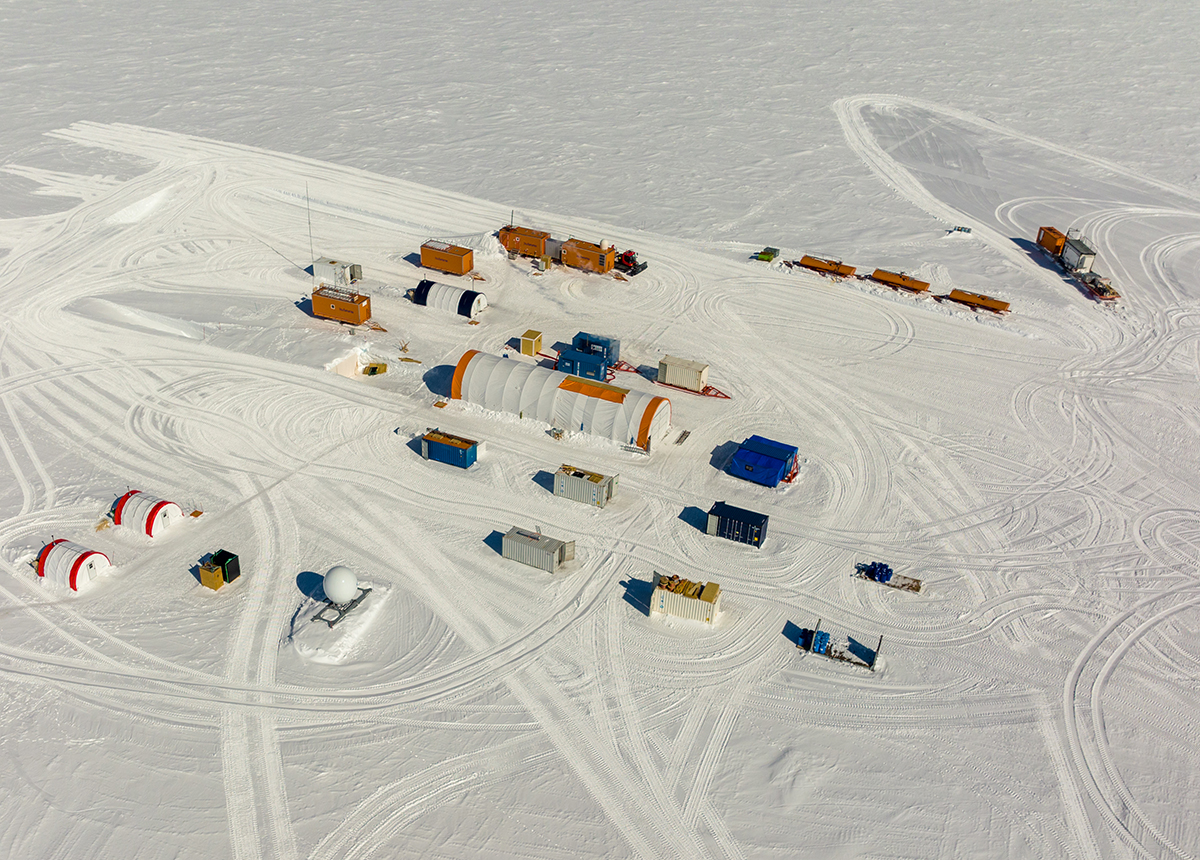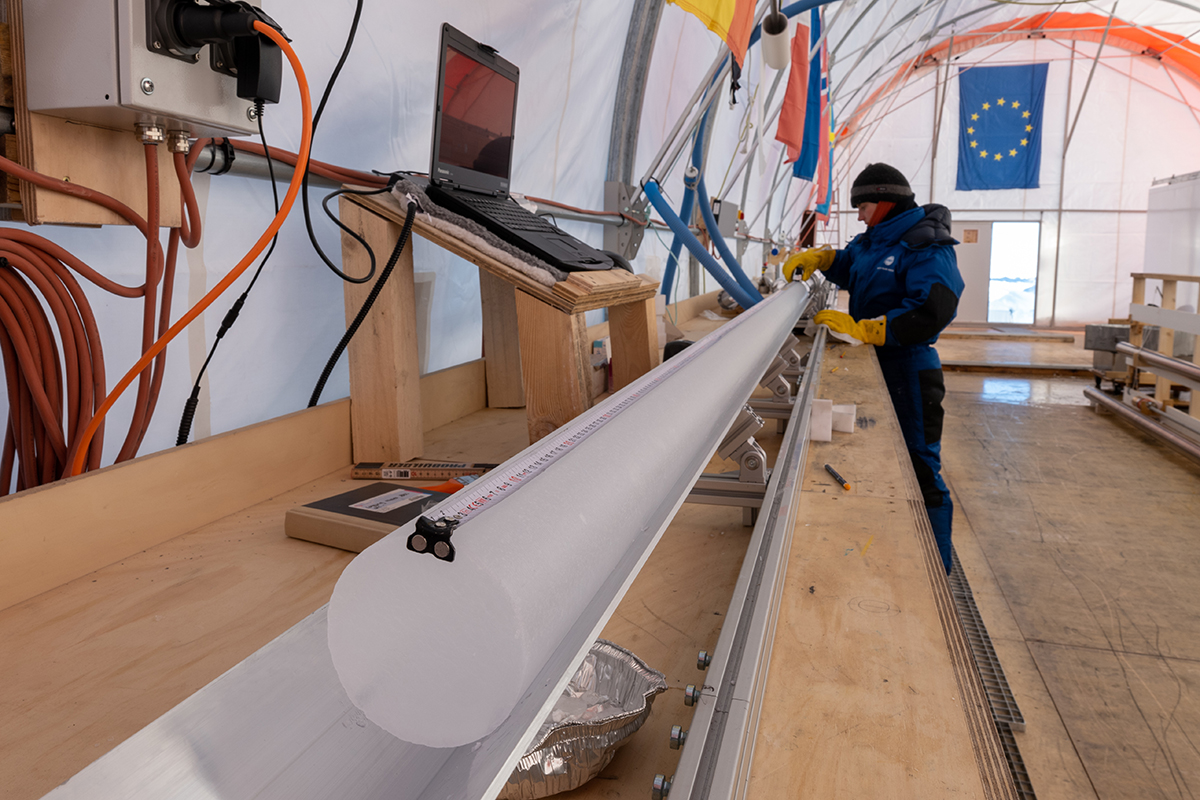Ice cores are a unique climate archive. Thanks to a new method developed by researchers at the University of Bern and Empa, greenhouse gas concentrations in 1.5 million year old ice can be measured even more accurately. The EU project “Beyond EPICA” with the participation of the University of Bern aims to recover such old ice in Antarctica.
Lesen Sie die originale Medienmitteilung hier.
The search for the oldest ice on earth has taken an important step forward. The Beyond EPICA – Oldest Ice project, a European consortium that includes the University of Bern, completed its second field season at the end of January. The drilling reached a depth of 808 meters. The project objective is to look back 1.5 million years into the past and obtain data on the development of temperature, the composition of the atmosphere and the carbon cycle. A depth of around 2700 meters must be reached in the Antarctic ice sheet and an ice core recovered. If everything goes as planned, this should be the case in 2025. Only then will the complex analysis of the oldest ice in this core follow, which new methods are currently being developed for.
The University of Bern plays a crucial role in the development of the new analysis technologies. The team led by Hubertus Fischer, professor of experimental climate physics and member of the Oeschger Center for Climate Change Research has succeeded, in collaboration with Empa, in developing a new technique to jointly measure the greenhouse gases carbon dioxide (CO2), methane (CH4) and nitrous oxide (N2O) as well as the carbon isotope composition of CO2. The ice sample needed for this is with a thickness of just one centimeter very small, yet the highest accuracy is possible in the measurement. “These are important prerequisites,” explains Hubertus Fischer, “for obtaining high-precision, high-resolution records from the oldest ice in Beyond EPICA.” In the 1.5 million year old ice, 15,000 to 20,000 years of climate history are compressed into just one meter of ice core, which places completely new demands on ice core analyzes. Ice cores are an extremely important climate archive because only they contain the air of the past to directly measure past greenhouse gas concentrations.
Perfect recycling of precious ice samples
The new method has just been published in the journal Atmospheric Measurement Techniques. The Bern Group worked closely with Empa researchers on the technical development for this. The team led by Lukas Emmenegger, head of Empa’s “Air Pollutants/Environmental Technology” department, developed a new laser spectrometer that can measure greenhouse gases on a sample of just 1.5 milliliters of air. "Achieving this high precision in such small samples was hardly imaginable for a long time. We are proud that this makes it possible to study the valuable ice cores," says Emmenegger. At the University of Bern, in turn, the new sublimation extraction system was devised and built that makes it possible to obtain such small air samples continuously and without contamination from an ice core. Thanks to this pioneering work, says Hubertus Fischer, it will be possible to take greenhouse gas measurements with the necessary precision and temporal resolution in such old ice.
Using the sublimation technique developed in Bern, an ice core sample can be slowly transformed from the top to the bottom from the solid to gaseous state. Individual samples are collected at centimeter resolution by freezing the air at -258°C during the continuous sublimation process. This technique ensures one hundred percent extraction efficiency. Another advantage of the method: the air extracted from the ice samples is not lost during the measurement in the laser spectrometer, instead it can be used for further analyzes afterwards. Hubertus Fischer speaks of “perfect recycling” and says: “The huge amount of work we have to put into the analysis would never be justifiable for an ordinary ice core.” It is for the 1.5 million year old ice though, as this the amount of old ice is extremely limited. Hubertus Fischer received a grant for cutting-edge research from the European Research Council (“ERC Advanced Grant”) as well as project funding from the Swiss National Science Foundation to realize these groundbreaking developments.
Drilling campaign under extreme climatic conditions
Hubertus Fischer is one of the main players in the Beyond EPICA – Oldest Ice project. An analysis of the Beyond EPICA ice core should contribute to a better understanding of the alternation between warm periods and the ice ages. Around a million years ago, there was a dramatic change in this back and forth – as shown by studies of marine sediments. In the time before around 900,000 years ago, ice ages and warm phases alternated every 40,000 years, afterwards only every 100,000 years. Why this change occurred is a mystery, but climate researchers suspect that greenhouse gases, among other things, played a crucial role. This assumption is now to be investigated by the ice core drilling in Antarctica, which goes back almost twice as far as the oldest Antarctic ice core analyzed so far.
In the project’s second drilling season, which has just ended, the international team worked for two months under extreme conditions. There were unforeseen setbacks such as repairs to the drilling system and delays due to poor weather conditions. Drilling was carried out in two shifts in 16-hour operation. The Little Dome C drilling site is located 34 kilometers from the French-Italian Concordia research station. At this expedition base station, the two Bernese researchers Markus Grimmer and Florian Krauss were tasked with cutting the ice cores into transportable pieces using a special saw developed by the University of Bern.
Information about the publication:
Lars Mächler, Daniel Baggenstos, Florian Krauss, Jochen Schmitt, Bernhard Bereiter, Remo Walther, Christoph Reinhard, Béla Tuzson, Lukas Emmenegger, and Hubertus Fischer, Atmospheric Measurement Techniques: Laser-induced sublimation extraction for centimeter-resolution multi-species greenhouse gas analysis on ice cores, 16, 355–372, 2023,
Oeschger Center for Climate Research
The Oeschger Center for Climate Change Research (OCCR) is one of the strategic centers of the University of Bern. It brings together researchers from 14 institutes and four faculties. The OCCR conducts interdisciplinary research at the cutting edge of climate change research. The Oeschger Center was founded in 2007 and bears the name of Hans Oeschger (1927-1998), a pioneer of modern climate research, who worked in Bern.
Further information: www.oeschger.unibe.ch
16.02.2023
Hier wird im Rahmen des europäischen Projekts «Beyond EPICA – Oldest Ice» nach dem ältesten Eis der Welt gebohrt: Das Camp in Litte Dome C in der Antarktis. © PNRA/IPEV

